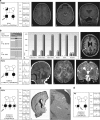Mosaic parental germline mutations causing recurrent forms of malformations of cortical development
- PMID: 26395554
- PMCID: PMC4929884
- DOI: 10.1038/ejhg.2015.192
Mosaic parental germline mutations causing recurrent forms of malformations of cortical development
Abstract
To unravel missing genetic causes underlying monogenic disorders with recurrence in sibling, we explored the hypothesis of parental germline mosaic mutations in familial forms of malformation of cortical development (MCD). Interestingly, four families with parental germline variants, out of 18, were identified by whole-exome sequencing (WES), including a variant in a new candidate gene, syntaxin 7. In view of this high frequency, revision of diagnostic strategies and reoccurrence risk should be considered not only for the recurrent forms, but also for the sporadic cases of MCD.
Figures

References
-
- de Brouwer AP: Mutation frequencies of X-linked mental retardation genes in families from the EuroMRX consortium. Hum Mutat 2007; 28: 207–208. - PubMed
-
- Erickson RP: Somatic gene mutation and human disease other than cancer: an update. Mutat Res 2010; 705: 96–106. - PubMed
-
- Wang H, Frelin L, Pevsner J: Human syntaxin 7: a Pep12p/Vps6p homologue implicated in vesicle trafficking to lysosomes. Gene 1997; 199: 39–48. - PubMed
Publication types
MeSH terms
Substances
LinkOut - more resources
Full Text Sources
Other Literature Sources
Molecular Biology Databases

